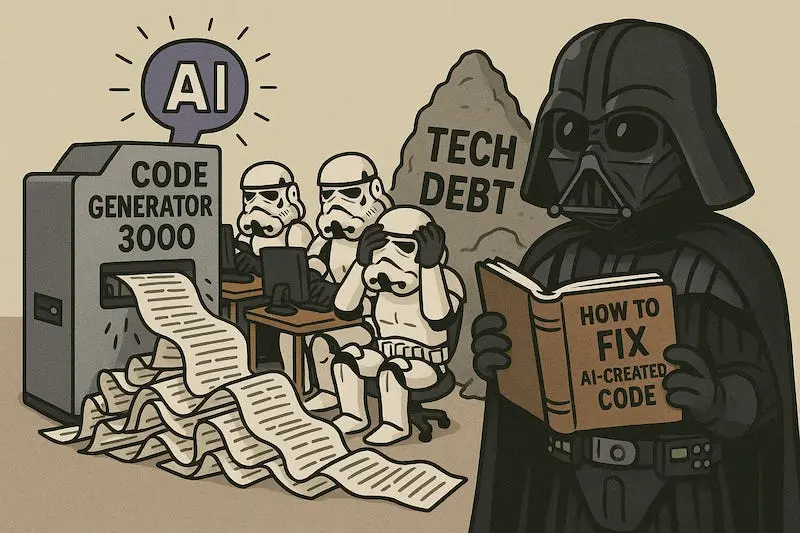
The Product-Engineering Manager Cold War: When Business Goals Clash With Technical Reality
An early-career PM's survival guide to navigating the inevitable conflicts between shipping features and paying down technical debt.
The tension is palpable. You’ve got the business case locked and loaded, revenue projections, customer demand metrics, competitive threats. Your Engineering Manager has the team’s morale, system stability, and long-term maintainability on their mind. Welcome to the most fundamental conflict in modern product development.
The Inevitable Battle Lines
Product Managers and Engineering Managers aren’t supposed to be adversaries, but their incentives create natural friction. PMs are measured by business outcomes and customer delivery. EMs are measured by team health and system reliability. When these priorities collide, you get the classic standoff: business releases versus technical debt.
One PM recently shared their experience of this exact scenario: their EM initially disagreed with prioritizing a business release over long-overdue tech debt. They eventually found a compromise by allocating ~20% of bandwidth to tech debt and the rest to the release. But even with data backing the business priority, personal frustration lingered.
This isn’t about personality conflicts, it’s about fundamentally different risk profiles. Engineering managers often have a much higher tolerance for technical risk than product managers, presumably because PMs are the ones who will ultimately be held accountable if something fails in the market.
Why Tech Debt Isn’t Just an Engineering Problem
Technical debt is often misunderstood as “engineering’s problem”, but it’s really a business liability that affects everyone. As one experienced PM noted, EMs prioritize tech debt because it directly impacts team health, causing drops in morale, excessive focus on maintenance over building, and eventually people leaving the team.
The analogy holds: tech debt is debt. The business team gets the loan, and eventually everyone needs to pay the interest. When you prioritize features over fixes, you accept the risk of that issue manifesting in unknown ways. This means engineering has a pretty large “told you” card to play when things go wrong.
The Trust Deficit That Fuels Conflicts
Engineering teams are often conditioned by past experiences with PMs who prioritize short-term delivery over long-term quality, throw the team under the bus with management when that comes home to roost, and move on after a few years leaving a long wake of technical debt. Engineering managers act accordingly until you’ve proved otherwise.
This creates a trust deficit that colors every prioritization discussion. The EM isn’t just evaluating your current proposal, they’re evaluating whether you’ll be there to own the consequences when the technical shortcuts inevitably cause problems.
Moving Beyond Binary Choices
The most productive teams recognize that prioritization isn’t a zero-sum game. Several strategies emerge from experienced practitioners:
The Measured Approach: One effective strategy involves reserving 10% of every roadmap for tech debt cleanup. If technical issues pile up and cause acute engineering team problems, some PMs push for a quarter where it’s roughly reversed, maybe 80% tech debt work, selling it to the business as increasing reliability.
The Data-Driven Method: Regarding tech debt, measure the outcome of doing it versus not doing it. If we don’t address a particular debt, we risk failure in model X that will impact revenue by Y. If we do address it, it will speed up requests by X improving KPIs by Y. This allows you to place tech debt alongside main tasks using comparable metrics.
The Golden Rule: No data = no place in backlog. This applies equally to feature requests and technical improvements. When developers push for rewriting a script from one language to another “because it will be easier to support”, demand metrics. What does “easier” translate to in hours saved, bugs reduced, or velocity increased?
When to Escalate (and When Not To)
Sometimes disagreements escalate beyond healthy debate. One PM shared an experience where an EM wanted to push an untested hotfix for a minor bug when they were already in a stretch of rough releases. The EM pulled rank, saying that because they could do the push, they were the final decision maker.
The hotfix was fine, but the precedent was dangerous. These situations require careful navigation, sometimes you need to escalate to higher management, but other times you need to recognize when you’re fighting battles that don’t warrant nuclear options.
Building a Partnership, Not a Rivalry
The most successful PM-EM relationships operate as true partnerships where both parties give and take. As one commenter wisely noted, “Look at it like a partnership, you both have to give/take.” When you’re fair to each other, you’ll often work on a mutually beneficial relationship.
This means product managers need to own the risks associated with not addressing technical debt and collaborate to balance quality and delivery. It also means recognizing that most deadlines are artificial constraints rather than existential threats.
The Compromise That Actually Works
The 20% bandwidth allocation for tech debt that the original PM mentioned is actually a recognized best practice. Many teams operate with a consistent 10-20% allocation for technical health work. This creates predictability for both sides, engineering knows they’ll get regular time for maintenance, and product knows most capacity remains available for feature development.
The key is making this allocation transparent and non-negotiable. When tech debt work becomes the first thing cut during crunch times, you reinforce the very distrust you’re trying to overcome.
When Disagreements Reveal Bigger Problems
Sometimes, persistent conflicts signal deeper organizational issues. If your engineering manager consistently pushes back on reasonable business priorities, it might indicate misaligned incentives or unclear accountability structures. Conversely, if you’re constantly fighting to prioritize technical health work, your organization might have a deeper cultural problem with short-term thinking.
These conflicts aren’t necessarily bad, they’re often the canary in the coal mine for organizational health issues that need addressing at a higher level.
Conflict as a Feature, Not a Bug
Product-Engineering Manager disagreements aren’t signs of dysfunction, they’re natural consequences of having advocates for different but equally important priorities. The healthiest organizations don’t eliminate these conflicts, they create frameworks for resolving them productively.
The next time you find yourself at odds with your Engineering Manager, remember: you’re both right. The business does need to ship features, and the systems do need maintenance. The art isn’t in winning the argument, it’s in finding the balance that serves both masters.



